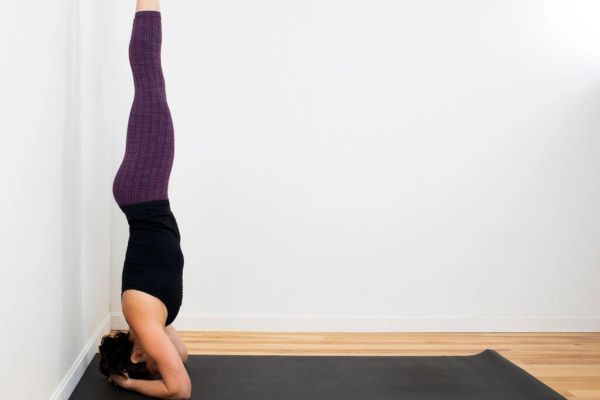Mastering the Headstand Pose (Sirsasana)

The Headstand Pose, or Sirsasana, is often regarded as the “King of Asanas” in the practice of yoga. Its inversion nature challenges the practitioner to embrace fear, build strength, and cultivate balance, both physically and mentally. This iconic yoga pose has been practiced for centuries and is considered a milestone in the yogic journey. In this comprehensive guide, we will delve into the various aspects of the Headstand Pose, exploring its benefits, variations, alignment principles, contraindications, and step-by-step techniques to help you master this awe-inspiring pose safely and confidently.
Understanding the Headstand Pose
Here are some importance of the headstand pose, its impact on on overall health, and a step-by-step guide on how to safely and effectively perform this empowering yoga posture.
1. The Significance of Sirsasana in Yoga
The Headstand Pose holds profound symbolic and physiological significance in yoga. Inverted poses, like Sirsasana, represent a shift in perspective, encouraging practitioners to see the world from a new angle. It is believed to stimulate the crown chakra, promoting spiritual awareness and clarity of thought. Physically, the pose provides a unique opportunity to reverse the effects of gravity on the body, benefiting the circulatory, lymphatic, and nervous systems.
Benefits of Practicing Sirsasana
a. Improved Circulation: The inverted position allows fresh oxygenated blood to flow to the brain, enhancing cognitive function and concentration.
b. Enhanced Strength and Core Stability: Headstand requires engagement of the core muscles, promoting a strong and stable midsection.
c. Improved Balance and Focus: The pose challenges balance, enhancing proprioception and mental focus.
d. Stress Relief: Practicing Sirsasana can have a calming effect on the mind, reducing stress and anxiety.
e. Boosted Immunity: The stimulation of the lymphatic system during the pose can enhance the body’s natural defense mechanisms.
Preparing for the Headstand Pose
Here are the step-by step instruction to do headstand pose
1. Developing Strength and Flexibility
Before attempting Sirsasana, it is essential to develop adequate strength and flexibility in the upper body, shoulders, and core. Practicing preparatory poses, such as Dolphin Pose, Downward Dog, and Plank, can help build the required muscular foundation.
2. Warming Up and Safe Practice
Warming up the body is crucial to prevent injuries during headstand practice. A gentle flow sequence that includes shoulder openers and neck stretches prepares the body for the inversion. It is also essential to practice Sirsasana on a non-slip yoga mat, ensuring a safe foundation for the pose.
Mastering the Headstand Pose
1. Wall-Assisted Headstand
Beginners can start by practicing the Headstand Pose with the support of a wall. This allows practitioners to focus on alignment, balance, and overcoming fear. Gradually, as confidence and strength build, the wall support can be reduced.
2. Headstand with Support from a Partner or Props
For added security and assistance, practitioners can perform Sirsasana with the guidance of a yoga instructor or a partner. Additionally, using props like yoga blocks or a headstand stool can provide extra support during the learning phase.
3. Full Headstand Pose
Once comfortable with the preparatory stages, it’s time to attempt the full expression of the Headstand Pose. Following proper alignment cues and engaging the core and shoulder girdle are essential to maintain stability and balance.
Alignment and Common Mistakes
1. Correct Alignment in Sirsasana
Maintaining correct alignment is crucial in Headstand to prevent strain or injury. Properly stacking the shoulders, hips, and legs is essential to distribute weight evenly and maintain balance.
2. Common Mistakes to Avoid
Various mistakes are common when learning Sirsasana. These include arching the back, collapsing the shoulders, and relying solely on neck strength. Addressing these mistakes early on will ensure a safer and more effective practice.
Contraindications and Modifications
1. Contraindications for Headstand Pose
The Headstand Pose is not suitable for everyone. Individuals with neck, back, or shoulder injuries, high blood pressure, glaucoma, or other medical conditions should avoid this pose. Pregnant women should also refrain from practicing Sirsasana.
2. Modifications for Beginners and Advanced Practitioners
Modifications can help individuals gradually progress in their Headstand practice. These include using props, practicing half headstands, or opting for supported variations to build strength and confidence.
Headstand Pose in a Yogic Lifestyle
1. Incorporating Sirsasana into Your Yoga Routine
Sirsasana can be integrated into a regular yoga practice as part of a well-rounded sequence. Pairing it with other inversion poses, such as Shoulder Stand (Sarvangasana), can create a powerful and transformative yoga flow.
2. Headstand as a Meditative Practice
The Headstand Pose not only offers physical benefits but also serves as a meditative practice. Practicing with mindfulness and breath awareness can deepen the experience and foster a greater connection between the body and mind.
You May Also Like:
5 things you can do right now to slow the ageing process
Conclusion
The Headstand Pose (Sirsasana) is a testament to the transformative power of yoga. As you embark on your journey to master this profound inversion, remember that patience, consistency, and respect for your body are key. Approach Sirsasana with a sense of curiosity and wonder, and it will not only challenge you physically but also enrich your understanding of yoga as a holistic and transformative practice. As you find your balance and grace in this pose, may it inspire you to embrace life’s challenges with a renewed sense of confidence and serenity.




